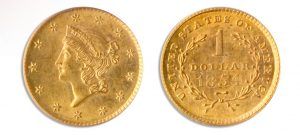The Gold Dollar: An Early American Currency Workhorse
Posted on — 1 CommentThroughout the history of civilization, gold has served as money – longer than any other material. In the early days of our union, the American government worked to create a gold dollar as a unit of currency. Indeed, as early as 1791, Secretary of the Treasury Alexander Hamilton first called for a one-dollar denomination gold coin. Yet, it took our young nation 58 years to actually mint the one-dollar gold coin.
Finally, with the Act of March 3, 1849, Congress authorized the production of the gold dollar and they were minted from 1849 through 1889.
The $1 Liberty Head gold coin is a special rarity and an outstanding example of pre-1934 gold U.S. coinage. There are three gold dollar types and Type 1 reveals the smallest diameter of any United States coin minted to date. In 1854, the design was updated to a feather headdress on the female, which is called the Indian Princess Head (Type 2). In 1856, the type was changed again to increase the size of the head (Type 3).
All three types were designed by Mint Chief Engraver James B. Longacre, who also designed the Indian Head cent and two-cent coins.
In the early years of its minting and up until he Civil War, the gold dollar was widely used in everyday commerce. That’s why most specimens you will find today show evidence of wear. Just imagine what these coins minted were used for – a knapsack, wool socks, a belt, a comb, soap, matches, a handkerchief, a harmonica, food, medicine or even whisky.
Once the Civil War began in 1865, however, amid the economic destruction of the war, gold dollars nearly vanished from circulation. Gold did not circulate widely again in much of the country until 1879.
Collectors today often seek to acquire one from each of the three different gold dollar design variations. Generally speaking, the scarcest is the Type 2.
Collecting gold dollars can be an exciting goal – though it will give collectors a challenge. Some of the harder coins to source include Charlotte and Dahlonega mint coins, with 1855-D, 1856-D, 1860-D, and 1861-D seen as prime rarities. From the Philadelphia Mint coins the important date is the 1875, of which just 20 Proofs and 400 business strikes were minted.
One numismatic strategy to acquire gold dollars is to build a type set. One could consider acquiring a gold type set, which would include the major design types from the mid-19th century forward: three types of gold dollars, Liberty Head or Coronet quarter eagle and Indian quarter eagle, $3 gold, Liberty Head half eagle, Indian head half eagle, Liberty Head $10, Indian $10, Liberty Head $20, and Saint-Gaudens $20 gold coins.
Historically, one of the best ways to invest in rare coins is to build a set. Often sets become more valuable than the sum of the individual coins. If you are interested in starting a set or are looking for an elusive coin to complete a set, contact a Blanchard portfolio manager today for guidance. Over the past 40 years, we have helped clients build simple and elaborate sets to help meet their financial goals. We can help you too.
Want to read more? Subscribe to the Blanchard Newsletter and get our tales from the vault, our favorite stories from around the world and the latest tangible assets news delivered to your inbox weekly.
1 thought on “The Gold Dollar: An Early American Currency Workhorse”
Comments are closed.








Gold for thousands of years has been the most prized possession. Replacing it with fiat introduced inflation in economy.